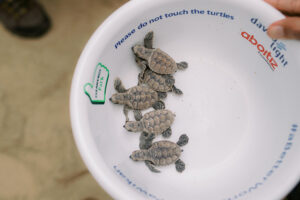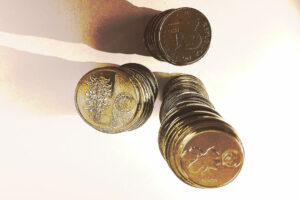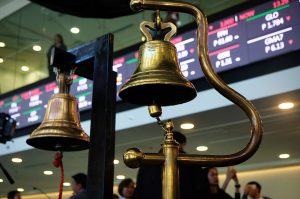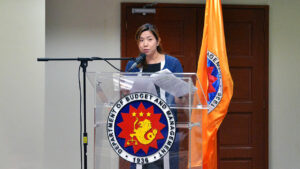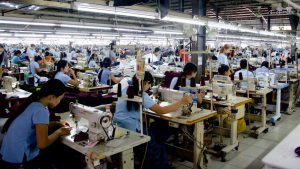While accustomed to a life on the move below water, female sea turtles use their geomagnetic abilities, or an internal GPS, to return to their place of birth and lay their own eggs.
At the same time, way above, migratory birds also possess their own inner compass, which guide them in moving from low resource areas to areas with high or increasing ones.
For both species, food and nesting locations are major considerations when determining where to go. This puts a premium on places that are bustling with plant life — mangroves for the turtles and trees for the birds — which host fishes and insects for their consumption. This puts emphasis on the importance of conserving and protecting these special sites.
Mangrove boardwalk. Visitors of Aboitiz Cleanergy Park can tour the site’s mangrove reforestation site and coastal forest — home to 108 different bird species — and, at the right timing, maybe even participate in the release of sea turtle hatchlings on its beach.
At the coastal area of Punta Dumalag, Davao, the Aboitiz Cleanergy Park stands as a sanctuary for sea turtles and various bird species, owing to initiatives to populate the site with more trees and mangroves, as well as conscious efforts to conserve and protect wildlife.
Sea turtles and mangroves
Sea turtles can lay over 150 eggs at a time. Beaches with mangroves are among the suitable sea turtle nesting sites since the mangroves’ roots and dense vegetation offer safety and protection from predators and the sea waves.
Hatched. A total of 9,507 sea turtle hatchlings have been hatched and released from the Aboitiz Cleanergy Park since 2014, according to Davao Light. Photo is courtesy of the distribution utility.
In some cases around the world, mangroves provide temporary shelter, hiding spots, and ample food for the sea turtles. Mangrove ecosystems foster a rich biodiversity of marine organisms, like small fish and crustaceans, making it an ideal breeding and feeding area.
At Aboitiz Cleanergy Park, park personnel patrol its beach to monitor sea turtle nesting activities. A team from Davao Light, an Aboitiz Power Corporation (AboitizPower) distribution utility, along with the Aboitiz Foundation and volunteers, help protect the area through educational campaigns, coastal clean-ups, and mangrove planting. Further, when the turtle eggs are seen to be vulnerable to being caught by the sea waves, they are transferred to the park’s turtle hatchery.
Hatched. A total of 9,507 sea turtle hatchlings have been hatched and released from the Aboitiz Cleanergy Park since 2014, according to Davao Light. Photo is courtesy of the distribution utility.
The park held its most recent sea turtle hatchling release last April, involving 90 hatchlings from a nest found in February. In total, 9,507 hatchlings have been released from the area since 2014. These turtles are immediately greeted by a rich coral reef surrounded by a 37-hectare Marine Protected Area.
While only a few will survive into adulthood, conservation efforts and proper waste management remain important to ensure that these endangered creatures can thrive in the oceans. Sea turtles help maintain the health of seagrass beds and coral reefs. Hawksbill sea turtles, in particular, live on coral reefs and, in their own way, give back to the environment by eating overgrown sponges that suffocate slow-growing corals, resulting in a healthy reef. They also help prevent the overpopulation of jellyfishes in the ocean.
Hatched. A total of 9,507 sea turtle hatchlings have been hatched and released from the Aboitiz Cleanergy Park since 2014, according to Davao Light. Photo is courtesy of the distribution utility.
To date, over 21,448 mangroves have been planted at the Aboitiz Cleanergy Park’s mangrove reforestation site and coastal forest. However, several natural and man-made factors have rendered its survival rate at only 30%, which emphasizes the need for continuous collaborative efforts to plant more mangroves and increase awareness of its importance to sea turtles and the rest of the natural world.
Birds and trees
An absolute hoot. The nocturnal gould’s frogmouth, a near-threatened species solely found in Southeast Asia, rests on a tree branch at the Aboitiz Cleanergy Park. Photo is courtesy of Davao Light.
Similarly, birds have a symbiotic relationship with trees. Most build their nests in trees as strong branches and dense canopies can keep their eggs and themselves safe from predators and other external threats. Barks are also adequate materials for building nests.
When it comes to food, flowers and leaves attract insects which are critical to a bird’s diet. Trees also provide other varieties of food, including sap, nuts, and fruit, as well as water that collects on its leaves, which birds use for drinking and bathing.
Golden. (L-R) The golden-bellied gerygone likes to stay in subtropical or tropical moist lowland or mangrove forests, while the golden-headed cisticola prefers grassy areas like rivers and wetlands. Pictures were taken by Peter Simpson at the Aboitiz Cleanergy Park.
Aside from the mangrove reforestation site, the eight-hectare Aboitiz Cleanergy Park also propagates multiple native tree species. Consequently, many species of birds — from migrants, residents, to localized endemics — consider it their home. Following a recommendation by the University of the Philippines Mindanao and the University of Southeastern Philippines back in 2013, the park steadily propagated trees in the area through years of joint efforts from the public and private sectors, enabling an increase in the number of bird species residing there — rising from just five in 2015 to 108 in 2024.
As observed by birdists who frequent the park, more trees meant more food and shelter that accommodated the influx of more bird species. This growth was further sustained by habitat conservation activities and proper biodiversity management which made it a safer reserve for the birds, especially as too few people move around the area.
In other parts of the country, other AboitizPower business units in Luzon, Visayas, and Mindanao also consistently champion initiatives throughout the past few years to plant more trees and mangroves and produce carbon sinks within their host communities.
Mangrove boardwalk. Visitors of Aboitiz Cleanergy Park can tour the site’s mangrove reforestation site and coastal forest — home to 108 different bird species — and, at the right timing, maybe even participate in the release of sea turtle hatchlings on its beach.
With its efforts, Aboitiz Cleanergy Park continues to be a model of habitat conservation and biodiversity management in an urban setting. It affirms the collective vision of various stakeholders — AboitizPower and the rest of the Aboitiz Group, the local and national government, the academe, and other friends and volunteers — to create a positive impact by preserving the environment and nurturing wildlife.
Spotlight is BusinessWorld’s sponsored section that allows advertisers to amplify their brand and connect with BusinessWorld’s audience by publishing their stories on the BusinessWorld Web site. For more information, send an email to online@bworldonline.com.
Join us on Viber at https://bit.ly/3hv6bLA to get more updates and subscribe to BusinessWorld’s titles and get exclusive content through www.bworld-x.com.

